Teer Hardy's Blog
March 16, 2023
The Creeds and Why We Need Them
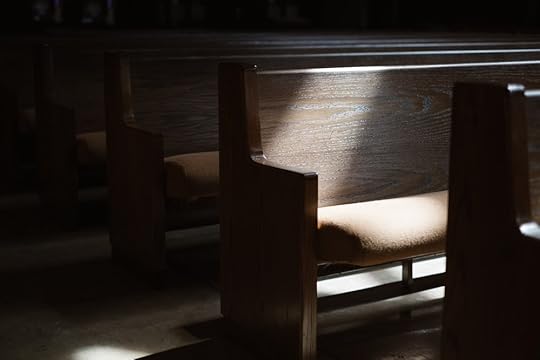
I recall reciting the creeds while sitting on the hard wooden pews at Calvary United Methodist Church in Frederick, Maryland. I remember thinking to myself that these recitations were unnecessary because they were delaying my post-worship donut. I imagine many feel this way today; feeling that the creeds are outdated, unnecessary, and unbending for the Church in a post-modern world.
The progress many in the Church seek to make comes by setting aside the ancient creeds of the Church, at times to the extent of casting aside Orthodox Christian teaching.
What if Orthodox Christian teaching and the traditions of the (ancient) Church could be the guidepost for the church in the United States and beyond as we navigate the temptation of “progress-ing” our way out of decline as we search for “relevancy” or whatever the buzz word of the week is?
That is a longwinded way of asking, do the ancient creeds of the church still hold value for the church 2000 years removed from the empty tomb?
Most books of worship, hymnals, and church polity books include, if not - prominently placed - the Apostles’ and Nicene Creeds.
Apostles’ Creed
I believe in God, the Father Almighty,
maker of heaven and earth;
And in Jesus Christ his only Son, our Lord;
who was conceived by the Holy Spirit,
born of the Virgin Mary,
suffered under Pontius Pilate,
was crucified, dead, and buried;*
the third day he rose from the dead;
he ascended into heaven,
and sitteth at the right hand of God the Father Almighty;
from thence he shall come to judge the quick and the dead.
I believe in the Holy Spirit,
the holy catholic** church,
the communion of saints,
the forgiveness of sins,
the resurrection of the body,
and the life everlasting. Amen.
The Nicene Creed
I believe in God, the Father Almighty,
maker of heaven and earth;
And in Jesus Christ his only Son, our Lord;
who was conceived by the Holy Spirit,
born of the Virgin Mary,
suffered under Pontius Pilate,
was crucified, dead, and buried;*
the third day he rose from the dead;
he ascended into heaven,
and sitteth at the right hand of God the Father Almighty;
from thence he shall come to judge the quick and the dead.
I believe in the Holy Spirit,
the holy catholic church,
the communion of saints,
the forgiveness of sins,
the resurrection of the body,
and the life everlasting. Amen.
The creeds originated because ancient Christians were insulating themselves against heresy in the church. Philip Cary writes that “a teaching in one of the most influential churches in the world was trying to get them to speak of Christ and say things like ‘there was once when he was not’ and ‘he came to be out of nothing.’” (The Nicene Creed: An Introduction. 2023.)
The ancient Church had good reason to insulate itself in that moments but to also ensure the Church that was to come would have the theological and orthodox resources necessary to proclaim Christ crucified, dead, resurrected, and ascended. This has always been the task of the Church. In his letters to the Corinthians, St. Paul writes to speak against false teachers in Corinth who were spreading a gospel contrary to the gospel of Jesus.
Creeds are the words the Church has used to speak a word together, with the Word Made Flesh as the source of the words we speak.. That is, the Apostles’ and Nicene Creeds are the words the Church has used over time and space to make sense of the faith we share. The creeds are not purely theological or academic statements reserved for clergy and academia while the rest of the church crosses their fingers. These statements of faith are but one part of ongoing conversations in the Church as we continue to articulate the Christian faith.
The creeds set a baseline for the Church but also serve as “performative acts,” writes my former theology professor Rev. Dr. Kendall Soulen. In his book, , Dr. Soulen points out that the creeds are how we live out our faith. Whenever the church raises its hands in confusion, not knowing what to do, Dr. Soulen argues we can look to the creeds.
The creeds are multi-layered declarations that reveal to use the unity of the Triune God
The creeds unify the Church.
OK, well, first and foremost Jesus unifies the Church but the creeds give the Church the language necessary to proclaim, with one voice, the Lordship of Christ.
The Church in 2023 is more divided than the ancient church fathers or first apostles could imagine. To the church in Corinth, St. Paul wrote, “in Christ God was reconciling the world to himself, not counting their trespasses against them, and entrusting the message of reconciliation to us.” And our creeds give the Church the baseline proclamation of our faith.
Because faith is a gift, and because our faith is constantly growing and changing, the creeds are not just ancient texts that we have to learn to recite; they are living documents that shape our very understanding of God and the world, and therefore shape our lives as Christians.
There is a temptation to progress so far is our faith that the ancient proclamations of the church, the texts that have guided the saints for generations, can be pushed aside for the sake of progress at the expense of Orthodox Christian teaching. And without Orthodox Christian teaching, without the theology and tradition of the Church we dangerously run the risk of creating a faith and god in the image of ourselves.
March 6, 2023
Taste
If you know me, then you know I find little pleasure in reading for pleasure. It’s not that I don’t like books or think reading is a waste of time. I think the reality of being in graduate school from 2011-2019, where reading is not necessarily done for pleasure, ruined me (OK, that sounds a bit dramatic, but you get the point).
As a pastor, one of my favorite parts of the gig is hearing the stories, people tell me in the church, at coffee shops, or in line at the grocery store. More often than not, these conversations are unsolicited, but they are always grace-filled and transformational.
This is why when a friend recommended that I try reading memoirs this year, I was hopeful I would find a book genre that I could enjoy.
Cue, Stanley Tucci, and Taste: My Life through Food.
“I am hardly saying anything new by stating that our links to what we eat have practically disappeared beneath sheets of plastic wrap. But what are also disappearing are the wonderful, vital human connections we’re able to make when we buy something we love to eat from someone who loves to sell it, who bought it from someone who loves to grow, catch, or raise it. Whether we know it or not, great comfort is found in these relationships, and they are very much a part of what solidifies a community.”
Tucci’s ability to connect the story of his family, career, and life to food hit the notes this pastor and theologian needed. Tucci unintentionally lays out the sacramental nature of life around a common table - a life that is sustained not by the actions of an individual, but rather a life that is sustained by the commonality of the meal. Tucci better understands what happens at Christ’s table than many pastors.
As he shares about his battle with cancer, Tucci writes, “I have chosen to write about this painfully iron experience because my illness and the brutal side effects of the treatment caused me to realize that food was not just a huge part of my life; it basically was my life… Watching my guests enjoy the meal I’d made filled me with great familiar pride. In those moments it was clear to mean that someday, when my parents are no longer alive, I will always be able to put their teachings and all the love they gave me into a bowl and present it to someone who sadly will never have had the good fortune of knowing them. But by eating that food, they will come to know them, if even just a little.”
Tucci lays out the why, and then jumps to the theology, which I have to admit I was not expecting in the last pages of this book.
“Until I began to fathom my deep emotional connections with food, I had always thought that the ceremonial eating of the communion wafer, a symbol for the body of Christ, was a strange, almost barbaric, pagan ritual. However, now it may well be the only aspect of Catholicism that makes any sense to me at all. If you love someone, you just want them inside you. (I know what you’re thinking, but let it go.) How many parents hug and kiss their kids and say, ‘I love you so much I just want to eat you up!’ Love can and does enter through the mouth.”
Tucci is explaining what we in the Wesleyan world call a “means of grace.” The Eucharist, Communion, or the Lord’s Supper, is a means by which we experience the amazing grace of God. We approach the Table the same way we may show up at a friend’s table or the dinner party of an acquaintance of an acquaintance - hungry, in need of nourishment, and while we could have chosen to be 1000 other places, here we are in a church fellowship hall or grand sanctuary with our arms extended to receive bread and wine.

In Taste: My Life Through Food, Tucci turned a memoir about food into an invitation to taste and see what the Lord has to offer.
That is the same invitation that is extended to all of us. The Lord invites all of us, those who love him, those who are frustrated or angry, and those who have not yet heard of his amazing grace, to come to the table, to taste and see.
To see what can happen with bread and wine.
To see what happens when Jesus is the host, and we are not.
To see how food, even the simplest foods, can change us from the inside out.
February 26, 2023
How Long, Lord?
February 26, 2023
Psalm 13 - Lent 1
“How long, O Lord? Will you forget me forever?
How long will you hide your face from me?
How long must I bear pain in my soul,
and have sorrow in my heart all day long?”[i]
Welcome to Lent. Today is the first Sunday in a forty-day journey toward the cross of Christ. A season full of self-examination and repentance; prayer, fasting, and self-denial; and reading and meditating on God’s holy word. As we make this journey, we know full well that the cross of Good Friday does not hold the last word, yet just as we cannot jump from Palm Sunday to Easter, we cannot jump from Ash Wednesday or the first Sunday of Lent to Easter. Our journey will be transformative; a continuation of the transfiguring Word of God.
We can expect to be transformed as individuals, but more importantly, we can expect to be transformed as Christ’s body. This journey will stretch us, moving us from complacency and complicity toward courage; courage to address our individual and corporate responsibility in the racial divide plaguing our communities and beyond.
We begin this Sunday with a psalm of lament.
“How long, O Lord? Will you forget me forever?
How long will you hide your face from me?
How long must I bear pain in my soul,
and have sorrow in my heart all day long?
How long shall my enemy be exalted over me?
Consider and answer me, O Lord my God!
Give light to my eyes, or I will sleep the sleep of death.”[ii]
The lament of the psalmist is a petition to God for God to address the distress experienced by the psalmist. Psalms of lament “tell the truth of the suffering that is smothering our worthiness, our dreams, our ability to work toward a better tomorrow,” writes Dr. Emilie M. Townes, Dean and E. Rhodes and Leona B. Carpenter Professor of Womanist Ethics and Society at the Vanderbilt University Divinity School. Dr. Townes continues, “Naming these horrors in an unrestrained lament helps mold us into a people who respond with an emphatic ‘No!’ to the ways our nation and our communities of faith are turned into graven images of hatred and despair.”[iii]
Laments are not only the cries of individuals. None of us can pray the lament of a psalm without having our lament, our earnest prayers, added to those of the generations who have prayed these prayers before us and those who are praying with us now.[iv]
So, as the psalmist cried out generations ago, when we pray the same prayer – How long, Lord? - our pleas of distress are added to the generations upon generations who have prayed this prayer.
How long, Lord?
Forever?
How long will we sit idly by while the byproducts of the racial segregation we tolerate Monday through Saturday stares us in the face on Sunday. [v]
How long, Lord?
How long will we ignore the systemic inequalities we allow to be embedded in nearly everything we do? From driving a car or shopping at Target to presumptions of innocence or guilt, our skin color predetermines initial encounters with the police, strangers, friends, and family.
How long, Lord?
In addition to our holy scriptures, we will use Jemar Tisby’s book How to Fight Racism as a guiding text for the coming weeks. Tisby is “convinced that Christianity must be included in the fight against racism as a matter of responding to the past.”
As Christianity moved out of Western Europe, it forgot that from the very beginning, as the dust settled from the world’s creation, as God was assembling bones and knitting human flesh, humanity was created in the image of God.
How long, Lord, will we forget that you said, “Let us make humankind in our image, according to our likeness; and let them have dominion over the fish of the sea, and over the birds of the air, and over the cattle, and over all the wild animals of the earth, and over every creeping thing that creeps upon the earth.”[vi]
To be a courageous congregation is to take seriously that since its arrival in North America, the Church has been established on the backs of black and brown bodies thanks to a legal document produced by Christ’s body. Issued by Pope Alexander VI, Papal Bull Inter Caeterea (1493) predates the arrival of the first enslaved persons in North America (1619) and set the tone for how our nation, communities, and churches were formed. This document asserted the rights of European Spanish Christians to colonize, convert, and enslave, all in the name of Christ. The document also justified enslaving Africans and transporting them across the Atlantic, tearing families apart and setting the stage for generations of enslavement and trauma.
So, before the pilgrims landed at Plymouth Rock in search of religious freedom, before the church and state were separated by the Continental Congress, and before John Wesley rode his circuit, the church in North America grew, evangelized, and converted, forgetting that all of us – spanning race, geography, and time – are created in the image of God. Imago Dei.
How long, Lord?
Part of the lament we lift about our role – active and passive – comes when the veil of ignorance is lifted from our eyes. The lifting of this veil is a continuation of the transfiguring work of God.
Growing up in the rural south, United Methodist Bishop Will Willimon did not know that his hometown of Greenville, SC, was at the heart of racial tension in the south. After leaving home and arriving at Wofford College, during a meeting with an academic advisor, Willimon learned of the lynching of Willie Earl. Earl was dragged from his jail cell by vigilante cab drivers guided by racial hatred and was killed, executed in what James Cone describes as the modern-day equivalent of being nailed to a cross. If you were wondering, the Earl’s killers were not convicted.
“That’s, er, awful,” Willimon said upon hearing the story kept from him by family members, friends, and a community unwilling to come to grips with its past.
“That there was a lynching? Or awful that they never told you that folks in your hometown did it.” his advisor replied.[vii]
How long, Lord?
How long will the shock of removing the veil of ignorance continue? How long will our ignorance continue?
“Psalm 13 is the cry of black Americans.” writes Jesuit priest Mario Powell. “We have been crying out this question for centuries”, he continues “But we cannot cry it alone anymore. Until you grow close to our suffering, until it fills your eyes and ears, your minds and hearts, until you jump up on the cross with black Americans, there can be no Easter for America.”[viii]
The difficulty of prayers of lament is that we can feel as though the Good News of Jesus Christ – the Easter celebration – is as far away as the day when Rev. Dr. Martin Luther King, Jr.’s dream becomes a reality.
The Good News is the object of our prayers and lamentations is the One who made the shadow-laden journey to the cross, and when death, the consequence of our sin, seemed to have won the day, asked Mary, “why are you crying? Who are you looking for?”[ix]
The help we expect, the help we so desperately need, does not come from ourselves. The track record of human history tells this to be true, and yet time and time again, we turn to ourselves to make right that which we continue to taint with our sin. Cries of lament are our turning toward God, acknowledging our humanness, and opening ourselves to being transformed. It is in being transformed that we can act first by setting side empty platitudes like “racism is too much, we have to give it to God,” and second, by actively working to correct generations of harm that was done in Christ’s name through acts of supposed mercy and compassion. The very things the Church has been called to do since the disciples were first called away from their fishing nets.
The transformation that comes, the coming reality of Dr. King’s dream, the fulfillment of the Kingdom of God, the Kin-dom[x] of God, is a gift to us by the One to whom we pray, the One who is actively working to transform his body, and the One who assures us we are never beyond the reach of God’s grace.
How long, Lord?
[i] Psalm 13:1-2
[ii] Psalm 13:1-13
[iii] https://reflections.yale.edu/article/...
[iv] In Psalms: The Prayer Book of the Bible Dietrich Bonhoeffer wrote, “No individual can repeat the lamentation of the Psalm out of their own experience; it is the distress of the entire community at all times” which unfolds.
[v] Jemar Tisby writes, ”the racial segregation we see on Sunday is downstream from the racial segregation we tolerate Monday through Friday. As such, fighting racism has to be something that goes beyond a once-a-week service. It must become habit, practice, and disposition.”
[vi] Genesis 1:26
[vii] In Who Lynched Willie Earl, Willimon tells the story of growing up in the rural south and guide preachers in how to see ”American racism an opportunity for Christians to honestly name sin and engage in acts of ’detoxification, renovation, and reparation.’”
[viii] https://www.americamagazine.org/faith...
[ix] John 20:15
[x] Using this term in place of “Kingdom” is my attempt to be open to being transformed, understanding that the word “Kingdom” is laden with baggage and harm that I am beginning to understand. I guess you could say the veil is being removed.
February 24, 2023
"You People" is a Warning, You People
Every now and then, there is an episode of Crackers & Grape Juice that leaves me wanting to continue the conversation beyond the prescheduled appointment. Our conversation with Liel Leibovitz is one of those conversations.
Liel joins the podcast to talk about his recent editorial in Tablet Magazine, but we talked about so much more. If you don’t enjoy this episode, there’s not much we can do for you.
Liel Liebowitz is a writer for Tablet magazine and host of the popular podcast, Unorthodox. Liel is an Israeli journalist, author, media critic and video game scholar. Leibovitz was born in Tel Aviv, immigrated to the United States in 1999, and earned a Ph.D. from Columbia University in 2007. In 2014, he was Visiting Assistant Professor of Media, Culture and Communication at New York University. He is the author of many books, including The Newish Jewish Encyclopedia, How the Talmud Can Change Your Life, and Stan Lee: A Life in Comics.
February 23, 2023
Grace is Not Always Practical
The other night I walked into Camden’s bedroom and asked him whatamden can devour a book in hours.
“I’m reading the Bible,” he said.
“You’re reading the what? The Bible?” I replied.
“Yeah, I’m reading the Bible,” he said with a bit of frustration.
Trying to be cool and nonchalant, I asked, “Well, what are you reading in the Bible?”
“I don’t know. I’m just flipping around. What do you think I should read?”
“This is my shot,” I thought to myself. “Pastor, don’t F this up.”
“Uh, check out Mark or if you’re not interested in that, we can find one of your favorite stories,” I suggested."
“I’ll figure it out,” he fired back.
Over the past five months, I’ve led a group of families at church in discovering how they can begin or start anew to teach their children about the faith they have been baptized into.
In Mini-Vangelism (thank you Rev. Drew Colby for the name) we have adult conversations about faith, raising kids in the church, the best ways to talk with our children about current events, and how to help our children explore God's presence as they go out into the world.
This past Sunday we wrapped up a study of Philipp Cary’s book Good News for Anxious Christians. Our conversation centered on story vs. theory or practicality. Living where we live, with the types of people in our community, it can be easy to skip over the story and skip straight to the application for our everyday life or theory.
Searching for practicality is what we do when we can’t make sense of the scriptures. Rather than looking for what the second person of the Trinty is doing in the gospels, we instead opt to split hairs over how to best apply a story we barely understand to our everyday life (as though there is a cookie-cutter model for everyday living).
What we neglect in our desire for practicality is the story being told. The story is what draws us in because each of us is in the story. Where we get lost is by misidentifying ourselves in the unfolding drama. Then, we get confused and begin looking for 5 simple steps to fill in the blank.
We label ourselves the Good Samaritan instead of the person in the ditch or the people who pass by.
We think ourselves to be the father running to meet the prodigal son when in reality we could be someone invited to the party not knowing what is going on or the brother who scoffing.
The Bible, from Genesis through Revelation invites us in because from cover to cover we find the good news of the gospel. But if we are constantly looking for a practical angel that is not the good news of Jesus Christ then we miss that the good news we are (possibly) glossing over is for us, for them, and for all creation.
We find the good news of Christ in his story, not ours.
Phillip Cary writes, “But the gospel is not a theory to apply; it’s a story to believe. It is good news that gladdens our heart, glad about—something we embrace by faith alone, not by doing something about it. To be precise, it gives us someone to be glad about. For the gospel, believing the story of our Lord Jesus Christ, does not give us practical advice or a theory about how to live our lives. It gives us God in the flesh.”
Think back to December or jump ahead to April. The stories of Christmas and Easter are two of the most well-known stories in all of humanity. The most casual Christian knows these stories. They may cross their fingers when reciting the Apostles’ Creed, or think the stories are nothing but fanciful tales, but these stories are known far and wide. And that is because these stories are shaping the world.
Whether we like it or not, God is at work. Changing hearts, minds, and the world, regardless of the practicality we attach to individual stories.
Practicality is not the gospel because by our standards the gospel is not practical.
In his book Between Noon and Three: Romance, Law, and the Outrage of Grace, Robert Capon wrote, “The Gospel is not a philosophy or a morality or a cultural tradition. It is an event. It is the story of Christ, God's incarnation and victory over death. It is the proclamation of a grace which is bestowed on a world of scoundrels who have no claim to it."
Story before practicality.
The story leads us to our theology.
Don’t get me wrong. Theology is important.
How we talk about God is important.
What we say about the Trinity is important.
That bread and wine transform in holy mystery into body and blood is important.
But the only way we can make sense of this theology is to immerse ourselves in the story and experience it for ourselves.
I walked back into Camden’s room after saying goodnight to Nora.
“Are you still reading?” I asked.
“Yeah, I’m reading about Noah. I like the story. I think it is my favorite,” he told me.
Then, without warning, he went into a stream of consciousness:
“Hey, dad, I don’t know if I believe this.”
“How could anyone make the water rise that fast?”
“No one lives to be 600 years old. Well, no one except Santa, and he’s like 300.”
“And how did the animals all get to the ark? They all couldn’t swim but some had to right? How could the polar bears get to the ark from the North Pole?”
“Those are some serious questions,” I told him.
He wasn’t looking for answers.
“Can I ask you a question? How do you think all of that worked itself out?” I asked.
“I don’t know, but it’s a good story and God can do anything, right?”
“Are you asking me?” I replied.
“No dad. I’m just saying, I’ve read the stories and there is some crazy stuff that happens. You preach crazy stuff. Your job is crazy.”
“If you only knew,” I thought.
“Listen, dude,” I said to him, “what do you think about the story? What’s your take?”
“Well, if God can do the stuff Jesus did, then why can’t God do the stuff with Noah? What story are we going to read next?”
“We"?” I asked.
“Yeah, I figure you know these stories. Let’s read them together.”
And with that, I was moved from practicality to story.
From practical to grace.
From life application to Good News.
February 19, 2023
Transfigured by Grace
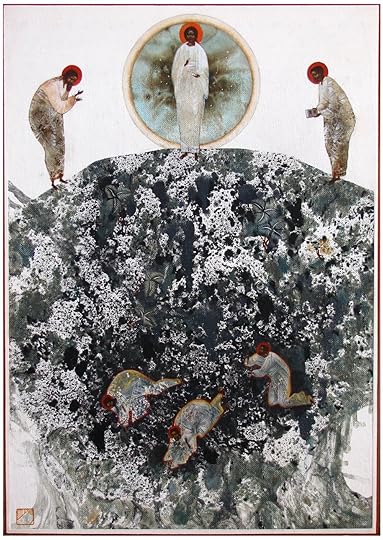
Transfiguration by Ivanka Demchuck
Six days after a dramatic journey through Caesarea Philippi – where Peter declared Jesus to be the Son of God, and Jesus foretold of his pending suffering, death, and resurrection – Jesus takes three disciples with him up a high mountain. Mountaintop experiences within Israel were known to be where a person would encounter God. Remember, after leading Israel to freedom through the Red Sea, Moses ascended Mount Sinai and descended back to his people with God’s Top-Ten after encountering God in a burning bush.
While on the mountain, Moses and the prophet Elijah appear, and Jesus is transfigured.
His face shines.
His clothing is dazzling white.
The same voice that called down from the clouds at the Jordan River, calls out again from the clouds, “This is my Son, the Beloved; with him, I am well pleased; listen to him!”[i]
You may not have realized it this morning when you decided to attend church, but today is a significant turning point in the church’s year. The Christmas decorations are neatly packed and put away. Epiphany is over. If the season of Epiphany was a crescendo, gradually and more grandly exposing the glory of Jesus of Nazareth, then the Transfiguration of Christ is the climax, the fortissimo.
[Image 2 - Lent Wooden Cross] As we prepare for the transition into the season of Lent, trading the bright lights of Epiphany for the shadows of Lent, the Transfiguration of Jesus is the grand revelation of who Jesus is – then, now, and forever.
Peter, the rock upon which the church was built, with his front-row seat to this event, was so moved that he wanted to commemorate the occasion by building memorials or tents. Peter wanted to make dwelling places for Jesus, Moses, and Elijah.
Three structures to commemorate the reveal majesty of God.
After all, Peter may have thought this could not, would not get more grand or divine than Jesus, Moses, and Elijah, and a voice from the clouds declaring Jesus to be the eternal begotten son of God, the creator of the cosmos, the Loquacious Word Made Flesh.
[Image 3 - Secret Quiet] As they descended the mountain, Jesus tells the three – Peter, James, and John – to keep the story to themselves, telling “no one about the vision until after the Son of Man has been raised from the dead.”[ii]
Jesus tells the three disciples, “Do not tell anyone about this until the thing I told you about 16 verses ago happens.”
[Image 4 - Byzantine Icon Transfiguration] According to the synoptic gospels – Mark, Matthew, and Luke – aside from the Resurrection of Christ, the Transfiguration is the grandest event in Jesus’ ministry. On the Transfiguration, Rev. Fleming Rutledge writes that the Transfiguration “is the most unambiguous revelation of Jesus as Messiah prior to the Resurrection.”[iii]
On the seventh day after their journey, the disciples, well three of them, see the glory of the Son of Man, the One who was with the Father on the first, second, third, fourth, fifth, and sixth days of creation, and who rested on day seven.
There were witnesses to the Transfiguration just as there were witnesses to Jesus calming the seas, feeding the ten thousand, and healing a demon-possessed boy. In his second letter, Peter wrote, “For we did not follow cleverly devised myths when we made known to you the power and coming of our Lord Jesus Christ, but we had been eyewitnesses of his majesty. For he received honor and glory from God the Father when that voice was conveyed to him by the Majestic Glory, saying, ‘This is my Son, my Beloved, with whom I am well pleased.’”[iv]
What, then, is the task of the preacher? What, then, is the task of the church with knowledge of the full majesty of the Son of God revealed to creation?
We could take the approach that even after the mountaintop experience, Jesus traveled down the mountain to continue his work, and we should do likewise. I have preached that sermon, and many of you graciously sat through that sermon which fell short because it failed to keep the glory of Jesus as the sermon's focus.
We could try to make sense of the Transfiguration in a very “Arlington” way by bogging ourselves down in the event's details, searching for nuance or explanations in the text.
But maybe there is another way forward that helps hold the tension of the transfiguration as we prepare to enter the season of Lent.
[Image 5 – Robert Jenson] American theologian Robert Jenson wrote, “The transfiguration is a promise and a foretaste of what it means to be made over in Christ’s image.”[v] As Jesus was transfigured before his disciples, the church (yesterday, today, and tomorrow) is transformed, transfigured by God’s grace, being made new in Christ Jesus.
Most of us move through our day reacting to the distractions that endlessly swirl around us. These distractions – tech, media, politics, the economy – attempt to transform us from the outside in, in the hope of conforming us into their image of who they want us to be: a user within an algorithm, a new customer, or a disciple to spread their agenda that is often contrary to the good news of Christ.
[Image 6 - Transfiguration Icon] The transfiguration of Jesus Christ is an invitation to the church to live a transfigured life.
The transfiguration of Christ is a sign that God is not content to leave us in our present state, but rather God is transforming us into something greater.
As we awaken, becoming the people God is shaping us to be, we can then follow the example of Christ, being bearers of his grace, mercy, and peace.
Our hearts are opened and our hearts are softened.
[Image 7 – Howard Thurman] A quote widely attributed to Christian mystic Howard Thurman put it like this, “God’s love is like a great furnace that can melt away our fears and doubts, leaving behind only a pure heart and steadfast spirit.”
[Image 8 – Transfiguration Ivanka Demchuk] The transfiguration of Jesus Christ, God's shining glory and splendidness, was not a one-off event. Every time the Word of God is proclaimed, every time water is blessed and falls over a person’s head, every time we gather around Christ’s table of grace, and every time we act wither mercy and compassion, we experience what John Wesley called means of grace, and we are transfigured.
As Jesus was glorified at the Transfiguration and set his sights on Jerusalem, we know the heavy lifting has been done. Making his way to the cross, Jesus carried the weight and guilt of our sin, as well as the glory that can only belong to the second person of the Trinity.
As he exited the tomb, the weight of the guilt of our sin was left behind so that his righteousness would be ours; his righteousness is ours. And it is the righteousness of God, revealed in Christ – born, transfigured, crucified, resurrected, and ascended – that transforms us, transfigures us, from the inside out.
For us, for you, on a hard wooden pew or sitting in a church basement… As we prepare to enter the season of Lent, as we trade the bright light of epiphany and journey toward the shadow of the cross, we are blessed because we get to experience this journey in light of the Transfiguration, as we journey toward the light of Christ’s resurrection. The way the means of Grace work, is they reveal to us the person and work of Jesus for us. Beholding his glory on the mountain, and then on the cross, and then in the empty tomb, all of this is done for us. And friends, that is what ultimately changes us as the hymn says, “from glory into glory.”
[i] Matthew 17:5
[ii] Matthew 17:9
[iii] Rutledge, Fleming and Lauren Bardolph Hubers. Means of Grace: A Year of Weekly Devotions. Wm. B. Eerdmans. 2021
[iv] 2 Peter 1:16-17
[v] Jenson, Robert. Systematic Theology, Volume 1: The Triune God. Oxford University Press. 1997.
January 9, 2023
Be Still and Know | Belovedness - January 8, 2023
In the fall of 2022, before the fire, before I knew more about insurance and fire and flood restoration, I would walk through the Sanctuary with my daughter every day after school. Each day we would hold hands as we walked through the hallway of the preschool, and as we made our way into the Sanctuary, Nora’s grip on my hand would get looser and looser. By the time we stepped into the Sanctuary, Nora would let go of my hand and make a b-line for the baptismal font.
On the top of her tippy toes, Nora would reach up with her hands, grabbing hold of the inside of the bowl, trying to lift herself higher than her four-year-old frame would allow.
“Pick me up, up, up!” she would shout. Her voice echoed through the Sanctuary as parents and caregivers hurried their children home for a snack and afternoon nap.
Every day I would walk over to Nora, place her unicorn backpack and lunchbox on one of the pews, and pick her up. As I lifted her, her hands would plunge into the water. At first, her hands would be gentle, but as her curiosity grew, the movement of her hands became stronger and faster. Then, usually without notice, water would splash on me as though I was seated in the Splash Zone during a Shamu show at Sea World.
Eventually, her hands would slow down, returning to a curious swirling of the water, and we would depart for our afternoon snacks and naps.
Each day after school, Nora asking her dad to show her where Pastor Ed and Bishop Will “got her all wet.” Each day a curious swirl turned into a joy-filled splash.
One afternoon, as Nora was poking her fingers into the water, I heard a voice from the door of the Sanctuary. Nora’s giggles echoed too much for me to hear what the person was saying.
“Excuse me,” I said as I set Nora down.
“I said, ‘what do you think you are doing?’”
“Oh,” I replied, “we were just playing in the water.”
“You’re playing?! In the baptismal water?! This is the church’s Sanctuary. I don’t think the church, or the pastors would appreciate you using their baptism water as your personal water table.”
“If I were you,” she continued, “I would stop before one of the pastors catches you and ask you to leave.”
I took a breath, looked at Nora, and said, “I don’t think the pastors would mind.”
But before I could introduce myself as Rev. Jeff Goodman, I was interrupted. The concerned preschool parent or caregiver, whom I had never met, said I should be ashamed for not teaching my daughter how to behave in a holy space. She said I should consider actually attending church so that I could learn what the water in the bowl meant.
“Yeah,” I reluctantly said, “I’ll consider that.”

John the Baptizer was a wild character. He lived in the wilderness and proclaimed a baptism of repentance for the forgiveness of sins. John was extending an invitation to all who would hear to prepare for the coming of the Messiah. Wearing clothing made of camel hair and sustained by a diet of locusts and wild honey, John’s invitation and baptism was a ritual act of turning away from a sin-filled life and reorienting one’s life on the righteousness of God found in the Law.
John’s baptism was a reminder of Israel’s baptism in Exodus when Moses parted the Red Sea as they escaped to freedom. Dr. Stanley Hauerwas writes, “Israel had to face death as it walked across the dry land between the walls of water. John’s baptism calls Israel again to face death so that it might live again. Repentance is about the life and death of the people of Israel.”[i]
The late Joseph Ratzinger, Pope Benedict XVI, wrote for John’s baptism, “the goal is truly to leave behind the sinful life one has led (until now) and to start out on the path to a new, changed life.”
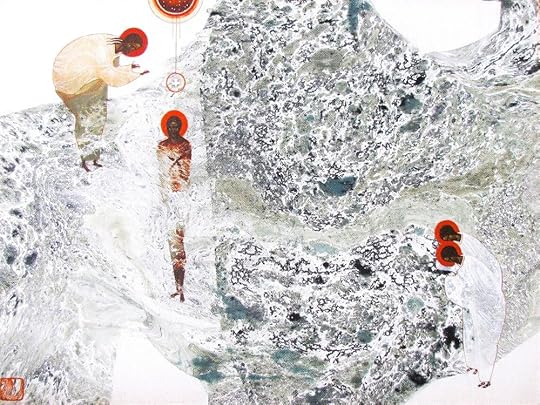
Jesus arrives in the wilderness at the Jordan River, and John rebukes Jesus.
“I need to be baptized by you, and do you come to me?” John said.
Speaking for the first time in the Gospel of Matthew, Jesus tells John that he, Jesus, must be baptized by John so that all righteousness is fulfilled. Jesus, the fulfillment of the Law, submits himself so that we might see the righteousness of God fulfilled. Jesus is placing himself under the Law, becoming like us.
Then, as Jesus resurfaces and the water breaks across his head and torso, the heavens break open, and the Holy Spirit descends like a dove. A voice called out, “This is my Son, the Beloved, with whom I am well pleased.”
And with that, the ministry of Jesus was unleashed on the world.
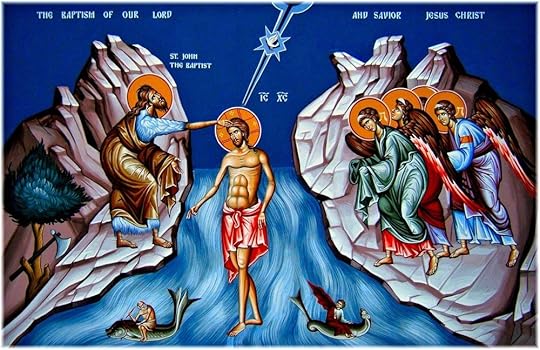
Submitting to John’s baptism, just as he will submit to his crucifixion, Jesus acts with the singular goal that we might know the goodness, the grace of God, and God’s rule over creation.
Just as Jesus became like us in every way, in our baptism – as an infant, child, teen, or adult – we are buried in a death like Christ’s. Dying to ourselves so that we can begin to live like Christ in every way, justified and innocent before God.
Just as the heavens opened and God declared, “This is my Son, the Beloved, with whom I am well pleased,” at your baptism, the same was declared.
“This is my child, my Beloved, with whom I am well pleased.”

Righteousness is a gift to each of us through the grace and faithfulness of Jesus Christ, and we are sealed with a declaration that you are beloved, in spite of what a sin-filled world says about you. The pressures of a world where our worth, our “belovedness,” is determined by how well we produce or perform, how well we hide our anxieties, or how well our children behave in public can cause us to forget that when Jesus’ ministry was unleashed on the world, the ways of the world took a backseat to the ways of God. And the ways of God begin with water.
Baptism is not reserved for those who have unwavering faith, those who perfectly understand the church's doctrines, or those who have accomplished every act of works righteousness declared to be required by someone wearing a robe or headset attached to a mic pack. The “belovedness” bestowed upon the baptized is for everyone.
Every single one of us.
For those we forget or say are unworthy.
For those in the cheap seats and those who sit in the front row.
For the scoundrels and losers.
For the sinners and saints.
Your “belovedness” is to be celebrated with childlike wonder and awe.
Rev. Dr. Martin Luther King Jr. wrote, “Baptism is not just a ritual; it is a way of life. It is not just about getting wet; it is about being reborn as a new creation in Christ.”[ii]
A new creation that sings and praises, proclamation and dancing, and giggles and splashes.
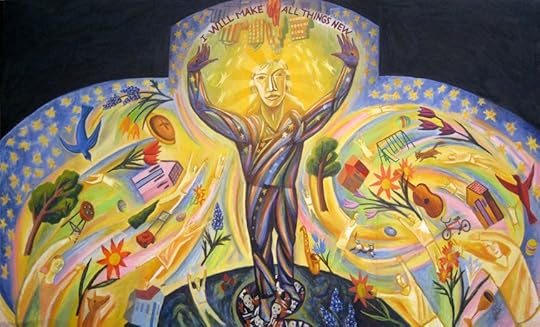
Baptism is not about securing a place for yourself in heaven. Baptism, as Rev. Fleming Rutledge wrote, “is about being sent into the world to live for Jesus right now.”[iii]
So go into the world, enjoying your “belovedness” so much that it causes people to stop, stare, and wonder what is happening.
Your “belovedness” is sealed. It is yours. Filled with childlike wonder and aw, remember your baptism and be thankful, and as you come forward in a bit to receive communion and remember your baptism… don’t be afraid to splash a little.
[i] Hauerwas. Matthew.
[ii] King. “Loving Your Enemies”
[iii] Rutledge, Fleming. Crucifixion.
January 1, 2023
God’s Perfect Time - January 1, 2023
If you are like me, then you have spent the better part of the past week in a cookie and cheese-induced daze. Every home I have visited over has offered a spread of cookies and cheese, front and center, for guests to enjoy. If Advent is a time for waiting and preparation, then the week between Christmas Eve and New Year's Day is a time for bloatedness and antacids. A time for raised blood sugar and a time for stretchy pants. A time for smoked sausages and crackers and a time for soup-based casseroles with fried onion topping.
Each year the time between Christmas Eve and New Year's Day feels like a time for muddling. Work schedules are less structured, end-of-the-year reports are due, and if you’re lucky, you have a few moments to reflect on the previous 365 days before you look to the next 365.
In the church we mark time with our liturgy. Even in a modern, free-spirited service like The Way, there is a liturgy; a pattern for how we worship and share our lives around Christ’s table of Grace.
There is a welcome and opening song, then an offering, prayer, another song, scripture reading, and finally the sermon. After the sermon, we confess our sins, receive a meal from Christ, sing, benedict, and depart. The next week, we will do the same thing again. For as free-spirited as this service is, there is predictability about everything we do. A time to sing and a time to pray. A time for more coffee and snacks and a time to reflect on the mercies of God. Even as the year rolls on, and the seasons move, and our circumstances change, our liturgy remains steady.
Your week may have gone to the dogs or your life may feel as though it is spinning out of control but come Sunday, we will gather to sing, pray, and give praise to the One through whom creation took shape.
A time for everything.
A time to plant, to kill, to tear down, to weep.
A time to uproot, to heal, to build up, to laugh.
Consider the past year. Maybe you made 12 car payments, a painted bedroom, finally repaired the leaking faucet in the kitchen, and replaced the couch no one would sit in for fear of not being able to stand back up.
Our scripture lesson invites us to consider what we have gained for our labors. From your laboring this past year, what did you gain?
A time for bills and housework.
A time to live.
A time for frustrations, doubts, vacations, and fancy dinners.
A time to die.
Ecclesiastes is considered wisdom literature in the Hebrew Bible. The author, a poet, captures the nature of human existence in its rawest, most limiting, yet all-encompassing form. Every event has a time and season. The good and the bad have a place within the human existence. The wise will discern how to act: a time to speak and a time to keep quiet, a time for action and a time to stay put.
We spend much of our lives planning and waiting for the perfect timing, trying to control things outside of our control as we attempt to move as our own gods through life, thinking that we have the ability to control the cosmos or set the stars into motion.
Do not get me wrong. My calendar is planned, uncertainty makes me uncomfortable, and my family will tell you I over plan to the point of planning out the fun of spotinanity.
A mentor of mine tells a story of when he was speaking at a theology conference in West Germany in the 1980s where he ran into a student he knew from his campus who was studying abroad. The two began to discuss the tension between the East and West. The student stated that from what she had seen and heard the Berlin would be falling within weeks. My mentor, kindly mocking the student’s optimism, repeated back the talking points he had read in the paper and heard during the evening news – nothing would change within the coming decade he said. Two weeks later, after returning back to the comfort of his campus in North Carolina, the wall fell.
The world tells us that wisdom is always knowing the right time but Ecclesiastes says that wisdom is to accept our finite creaturely status and face the facts – there is too much outside of our control for us to control much of anything.
Time, the right time, is in God’s hands not ours.
The Apostle Paul wrote, “While we were still weak, at the right moment, Christ died for ungodly people.” Christ came at the right time, and at the right place – a time and place that still baffles us today. That is what we remember, celebrate, and proclaim at Christmas. Mary and Jospeh did not fully know, but God knew.
We wait for the right time, for things to be perfect, and in the process miss out on the life God has given us.
I counseled a couple at the height of the pandemic as they prepared to get married. They changed the date and venue of their wedding three times, wanting the day to be perfect. Finally, I told them I had yet to officiate or attend the perfect wedding. The rain will come, you will forget the rings, or the caterer will poison your guests. “Pandemic or not,” I said, “you will never find the perfect time.”
The wisdom of Ecclesiastes tells us to continue on our way, eating and drinking and taking pleasure in what we have (and as of late, that is cookies and cheese), and one day we will look back, and by the grace of God, it is the right time.
We, you and I, for all our strengths and abilities are not gods and will never know the right time. The best we can do is mark time in the ways Jesus instructed us: in worship, around Christ’s table, and in remembering that the author of time has called each of us beloved, forgiven, and free. The good news is this – wherever we are headed this year, in the seasons that lay ahead of us, we are held in the hands of God, and by God’s grace it will be well.
December 24, 2022
Storyteller | It’s All in the Details - December 24, 2022

As far back as I remember, the Christmas story has not changed. A mash-up of Luke and Matthew’s accounts is etched into my mind: Mary and Joseph are both greeted by the angel Gabriel, wise men traversing a far, shepherds keeping their flocks by night, no room in the inn, and the manger. Oh yeah, and sweet baby Jesus. I could tell you the story and leave out one or two parts, and you wouldn’t miss a beat. Everyone knows this story.
Every year, regardless of national or global events – during war and peacetime; before a pandemic and during; as a child, adult, or slightly older adult – the story is read, “pageanted” and preached around the world. We did this last year and the year before, albeit online, we are doing it tonight, and if I did the math correctly, we will do this again in 365 days.
So, what is it about the story of the birth of the Messiah that brings us back year after year?
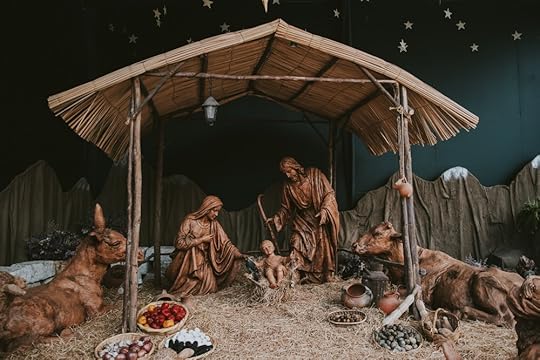
We know this story so well that we can recite it from memory. You know the story, and yet, like all great stories, without the details of the story, without mining the words of the gospels, Jesus’ birth can come across as not very noteworthy. But it is the details that take an inconspicuous family in a one-donkey town and places them – the town and the family – front and center on the world stage for generations to come.
The Good News of the story is in the details we so often overlook or forget.
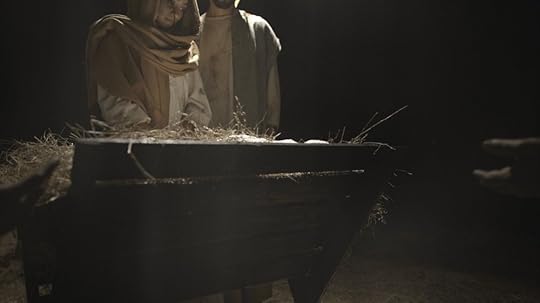
The holy family traveled from Nazareth in Galilee to David’s city, Bethlehem. The glory days of ancient Israel were during the reign of the giant-slaying, shepherd-king who hailed from downtown Bethlehem. Joseph, Mary’s betrothed, a descendent of David, was headed to his ancestorial home to be counted. The occupying Roman Emperor ordered a census be conducted for the purposes of collecting taxes. While in Bethlehem, Mary gave birth to her son, and the angels hailed him as “savior” and “Lord.” Titles reserved for the Roman Emperor and not a baby born in a one-donkey, backwoods town to a no-name family and laid in a feeding trough.
Pay attention to the details.
Mary grows a child without the help of a man
Joseph gets upset because he doesn’t understand
Angel comes to Joseph in a powerful dream
Says “God did this and you’re part of his scheme”
Joseph comes to Mary with his hat in his hand
Says “forgive me I guess really didn’t get the plan”
She says “you’ll didn’t trust me, but that’s okay
and guess what I felt the baby kick today”
Like a stone on the surface of a still river
Driving the ripples on forever
Redemption rips through the surface of time
In the cry of a tiny babe
Pageant directors take a creative license at this point because the gospels make no mention of cattle lowing. The only mention of animals is connected to the shepherds, “keeping their sheep at night.” But the shepherds said to each other, “Let us go right now to Bethlehem.” No mention of the flock tagging along for the holy field trip. No animals are mentioned as being present manger side, and yet, the temptation to romanticize is still present. For not of Christmas sentimentality, the Nativity scenes on our mantles along with the Hallmark Channel’s December lineup would be bare.

The Christ-child was not laid in a crib, wrapped in a quilt sewn by the kind people of the local synagogue. Jesus was laid in a manger. The bread of God, which has come down from heaven and gives life to the world, the very bread of life, first rested in a feeding trough.

Mary and Joseph were first-time parents and on the road. Mary and Joseph were experiencing the pangs and joy of welcoming a child into the world without the help of family, aunts, grandmothers, uncles, and cousins, not unlike many today because of scandal, shame, or the continuing pandemic.
There is one last detail I want us to explore, and it is the detail that could keep us here all night: finding ourselves in the story. You know the story. You could probably preach this sermon better than most preachers. So where are you in the story? There is something in this story that convinced you to be here tonight. Something in this story convinced you to put on your Christmas best and head to church. The story is so convincing we find ourselves drawn to the narrative. Our role or location can change at any given point in our lives.

We could be the innkeeper, unaware of what was about the occur in the rented guestroom.
[Image 8 – Shepherd] Or maybe a shepherd hearing the glorious, good news of Christ’s birth proclaimed in a church or experienced when the church acted as Christ’s body in the world—being so convinced of what you just heard that you would leave your livelihood behind to go and see what has happened for yourself.
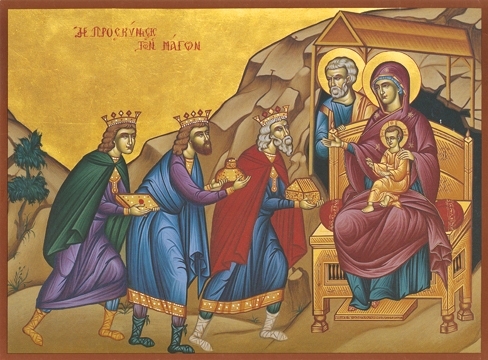
Are you arriving later in the story, a wise man? You are curious about what has occurred and are compelled to travel afar (or short) distance to see for yourself. The birth of the Messiah, good news for those in Israel along with all of creation.
Pay attention to the details.
The child is born in the fullness of time
Three wise astrologers take note of the signs
Come to pay their respects to the fragile little king
Get pretty close to wrecking everything
‘Cause the governing body of the Holy Land
Is that of Herod, a paranoid man
Who when he hears there’s a baby born King of the Jews
Sends death squads to kill all male children under two
But that same bright angel warns the parents in a dream
And they head out for the border and get away clean
Like a stone on the surface of a still river
Driving the ripples on forever
Redemption rips through the surface of time
In the cry of a tiny babe
Perhaps a combination of these locations or a bystander who overheard the shepherds, “glorifying and praising God for all they had heard and seen.”
The details, along with our location, make this story one we cannot forget and one we need to hear time and time again. This story is not just a good fireside read. The story of Christ’s birth gives life to the church and has redeemed all of creation.
[Image 10 - José y Maria] Christmas is not the anniversary of Christ’s birth. What we do here tonight is more than a birthday party with a great band/choir providing entertainment. Tonight, we remember, proclaim, and celebrate. Remember, proclaim, and celebrate that through the incarnation God has entered the mess of the world. And when the mess of the world tries to stomp out the Good News of the incarnation on a cross, the Grace of God says “no,” with the empty grave and burial clothes left behind.
Tonight is an active remembrance of what God accomplished through the details of a story that everyone knows.

Tonight, we proclaim the birth of Christ and the birth of a new creation, the salvific work of God, for all creation, for all people, spanning time and geography.
Tonight, we celebrate the incomprehensible inbreaking of the holy God getting physical with creation. As present then as he is now when we gather around his table of grace.

Tonight, we proclaim the birth of Christ and the birth of a new creation, the salvific work of God, for all creation, for all people, spanning time and geography.
Tonight, we celebrate the incomprehensible inbreaking of the holy God getting physical with creation. As present then as he is now when we gather around his table of grace.

A mystery, to be sure, but with the details to draw us in, our only response is to join the shepherds by singing our thanks and praise.
There are others who know about this miracle birth
The humblest of people catch a glimpse of their worth
For it isn’t to the palace that the Christ child comes
But to shepherds and street people, grifters and bums
And the message is clear if you’ve got ears to hear
That forgiveness is given for your guilt and your fear
It’s a Christmas gift you don’t have to buy
There’s a future shining in a baby’s eyes
Like a stone on the surface of a still river
Driving the ripples on forever
Redemption rips through the surface of time
In the cry of a tiny babe
December 11, 2022
A Griswold Family Advent
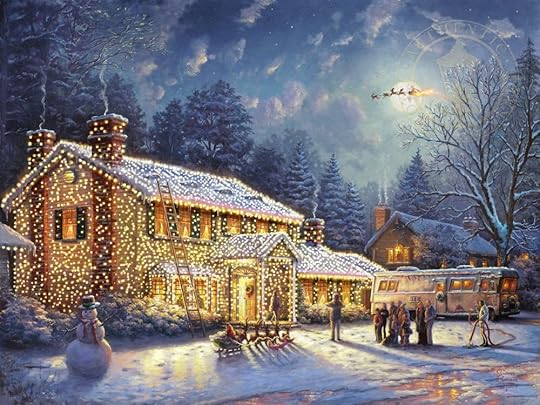
Every year, without fail, from Thanksgiving through New Year's Eve, I watch National Lampoon’s Christmas Vacation at least once per week. I know it is time to begin the annual shift toward Advent thanks to Clark, Ellen, Cousin Eddie, and Ruby Sue.
Poor Clark.
All Clark wanted was a house covered in lights, his family gathered around the dinner table, and to have the happiest Christmas since “Bing Crosby tap-danced with Danny (f—ing) Kaye.”
But that’s the Christmas we all want, right? I spent the day yesterday with the family watching a holiday classic, wearing a green elf hat, and throwing snowballs across a movie theater in the hope of creating what Clark couldn’t. And judging by the sold-out theater and the sold-out shows after our showing, I was not the only one.
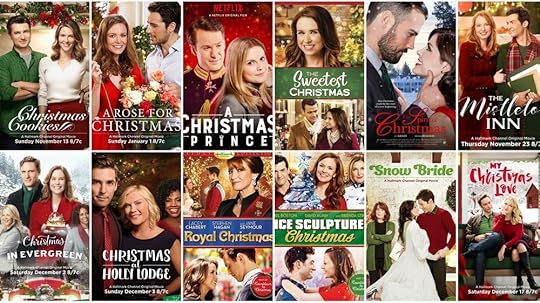
The temptation to over-sentimentalize or create the greeting card Christmas grows as we moved from Thanksgiving to Advent, and now Advent toward Christmas. Hallmark movies, specialty holiday drinks, cookies and cards, and perfectly curated nativity scenes invite us to go full Clark Griswold and forget the world in which we live; to forget the world in which God entered through a child (the stained-glass language word for this is “Incarnation”). The same themes persist yearly: “war, crime, violence, poverty, racial hatreds, totalitarian oppression, religious persecution, torture, selfishness, greed.” In a sermon she wrote in 1984, Rev. Fleming Rutledge observed that year after year, she had “little difficulty” finding horror sermon illustrations. She asks, “what would you like to wager about Christmas next year?”[ii]
Do not get me wrong. My family has an inflatable Olaf, Jack Skellington, unicorn, and flamingo in our front yard. I rarely pass on a specialty holiday drink, and the nativity scene on our mantle looks nothing like the scene described by Matthew and Luke. As I said, I will watch Christmas Vacation more than once per week this month, and if you ask my wife, she’ll tell you I am more like Clark Griswold than I would care to admit.
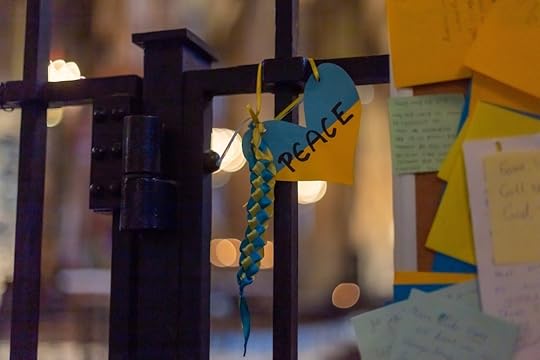
Every year, war, crime, violence, poverty, racial hatreds, totalitarian oppression, religious persecution, torture, selfishness, greed- aka Sin – persist. Still, the bright lights on Abingdon Street and the smell of gingerbread and peppermint invite us to forget, even if just for a moment, that the world is not how God would have it. To put it theologically: the world is messed up.
Matthew’s account of the first Advent ensures that the Church does not overly forget the messed up-ness of Advent, Christmas, or the Good News of the Gospel.
The first time I served as a liturgist in the church was on Christmas Eve, just after I began classes at Wesley Theological Seminary. Because I was a newly minted seminary, I thought I knew everything my congregation and I needed to know about the Bible and church. Just like the first-year college students returning home for winter break, ready to teach their families about the ways of the world, I did not heed my pastor's advice. I did not read the assigned scripture before the service.

“Our scripture reading is from the Gospel of Matthew, chapter 1, verses 1-17,” I confidently said.
“A record of the ancestors of Jesus Christ, son of David, son of Abraham:
Abraham was the father of Isaac.
Isaac was the father of Jacob.
Jacob was the father of Judah and his brothers.
Judah was the father of Perez and Zerah,
whose mother was Tamar.
Perez was the father of Hezron.
Hezron was the father of Aram.”[iii]
The genealogy of Jesus.
I took a deep breath when I got to King David, grabbed the lectern, and hoped for the best. The names I could barely pronounce were a who’s who of the good, the bad, and the ugly of the Hebrew Bible.
Today's scripture lesson skipped the first 17 verses (you’re welcome), but the verse that connects our lesson to the list of names – 42 generations in 3 sets of 14 – is in verse 20.
“Joseph son of David.”[iv]

Before Matthew speaks of angels visiting Joseph in his sleep, before the Magi, before John prepares the way of the Lord, and before the disciples are called, and the sick are healed, Matthew wants his readers to know that Jesus of Nazareth – the man who healed the sick, fed the hungry, ate with sinners, and was nailed to a tree – is the One for whom Israel waited.
The prophet Isaiah would have been front and center in the minds of Matthew’s original audience as they read or heard Matthew’s words. Matthew’s audience were Jewish Christians, expelled from the synagogues for following Jesus. So, as Matthew names Abraham, Jacob, Tamar, Hezron and Ram, Salmon, Boaz, Ruth, Obed, Jesse, and David, the words of the prophet Isaiah would have been percolating in the minds of his audience. Remember, these people knew their Hebrew Bible better than any of us can imagine.
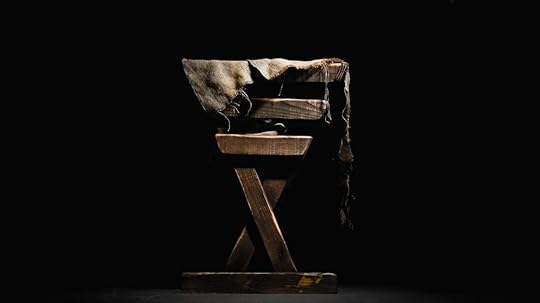
“A child is born to us, a son is given to us,
and authority will be on his shoulders.
He will be named
Wonderful Counselor, Mighty God,
Eternal Father, Prince of Peace.
There will be vast authority and endless peace
for David’s throne and for his kingdom,
establishing and sustaining it
with justice and righteousness
now and forever.”[v]
The reign of King David was the golden era for ancient Israel. When Matthew’s first audience heard this story, they were expelled from their synagogues, most likely poor and ostracized, and living under Roman rule. A far cry from the glory days for which they longed.
But baked into “Joseph son of David,”[vi] is the Good News of the Incarnation.

The 42 generations before Joseph would not make the cut for a Hallmark Christmas special – and Matthew’s original audience knew this. I imagine the kids are not learning about Tamar, peeping-Tom King David, or any other names we omitted from Advent 2022. But if they are, parents, good luck at lunch today.
Take Abraham, for instance, the patriarch of 42 generations. He lied about his wife, claiming her to be his sister, had a child with a woman he enslaved, and nearly slit the throat of his son Isaac.
Tamar, a widow, disguises herself as a prostitute. She also sleeps with her father-in-law. When the father-in-law finds out Tamar sold her body, he orders her to be killed, only to call off the execution when he learns Tamar is pregnant with his child, Perez, who is also mentioned in Jesus’ family tree.
Then there is David, the peeping-Tom king who had his best friend sent to the frontline of a war to ensure he was killed so that David could take the man’s wife for himself, Solomon’s mother, Uriah’s wife. Bathsheba is not listed by name, but when Matthew writes, “Joseph son of David,”[vii] her name and story are baked into the Good News of the Gospel.
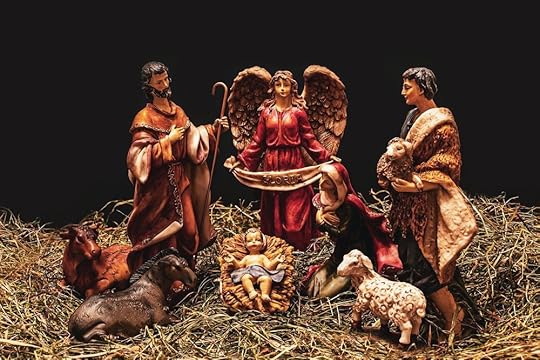
Pastor Susan Robb notes that the first readers of the story would have known “the good, the bad, and the ugly of their shared history and that God was faithful to their family in the midst of their inevitable family heartbreaks, challenges, joys, and yes, even dysfunction. Matthew opens with a genealogy not only to intrigue his audience with triggers of their shared memories, but also to make certain that they know that Jesus, the last person to be added to the genealogy, is the fulfillment of all that God was doing throughout the life of Israel.”[viii]
In skipping verses 1-17, we miss that the Good News of Advent and Christmas is even better than a Griswold Family could imagine. God is stepping into, not over or around, the messiness and brokenness of the world. The angel’s message to Joseph is that the stumbling blocks of past, present, and future do not prohibit or inhibit God’s salvific work.
We do not have to wait for the world to be perfect.

The tree will be the wrong size or shape.
The turkey will be dry.
Your end-of-the-year bonus may come in the form of a jelly subscription you did not want.
The relatives you dread seeing will overstay their welcome.
And, that powder room appliance might be full.

No matter how much we try to avoid the broken and messiness of the world and our lives, the birth of Joseph’s boy tells creation that we are not separated from God.
Our story is not Jesus’ story; instead, Jesus takes the world's story, our Sin – our the messy side of ourselves that we try to hide during the holidays – upon himself.
The peace we want on earth, the peace we will attempt to create for ourselves is here, through the grace of God, through a child, through a family as messed up as mine or yours.
[i] Matthew 1:20, CEB
[ii] Rutledge, Fleming. Pg 385.
[iii] Matthew 1:1-3
[iv] Matthew 1:20, CEB
[v] Isaiah 9:6-7
[vi] Matthew 1:20
[vii] Matthew 1:20
[viii] Robb, Susan. Pg. 55.



